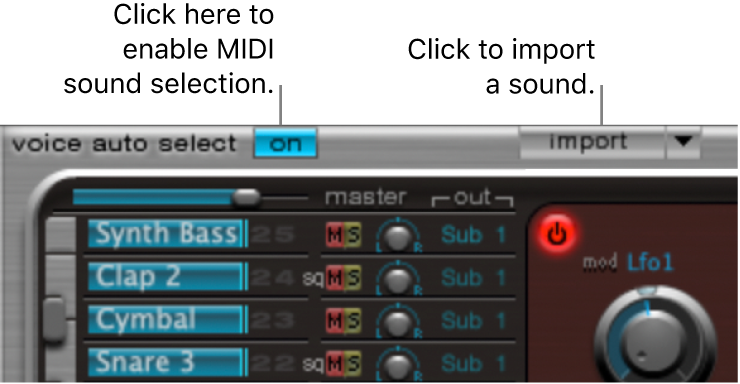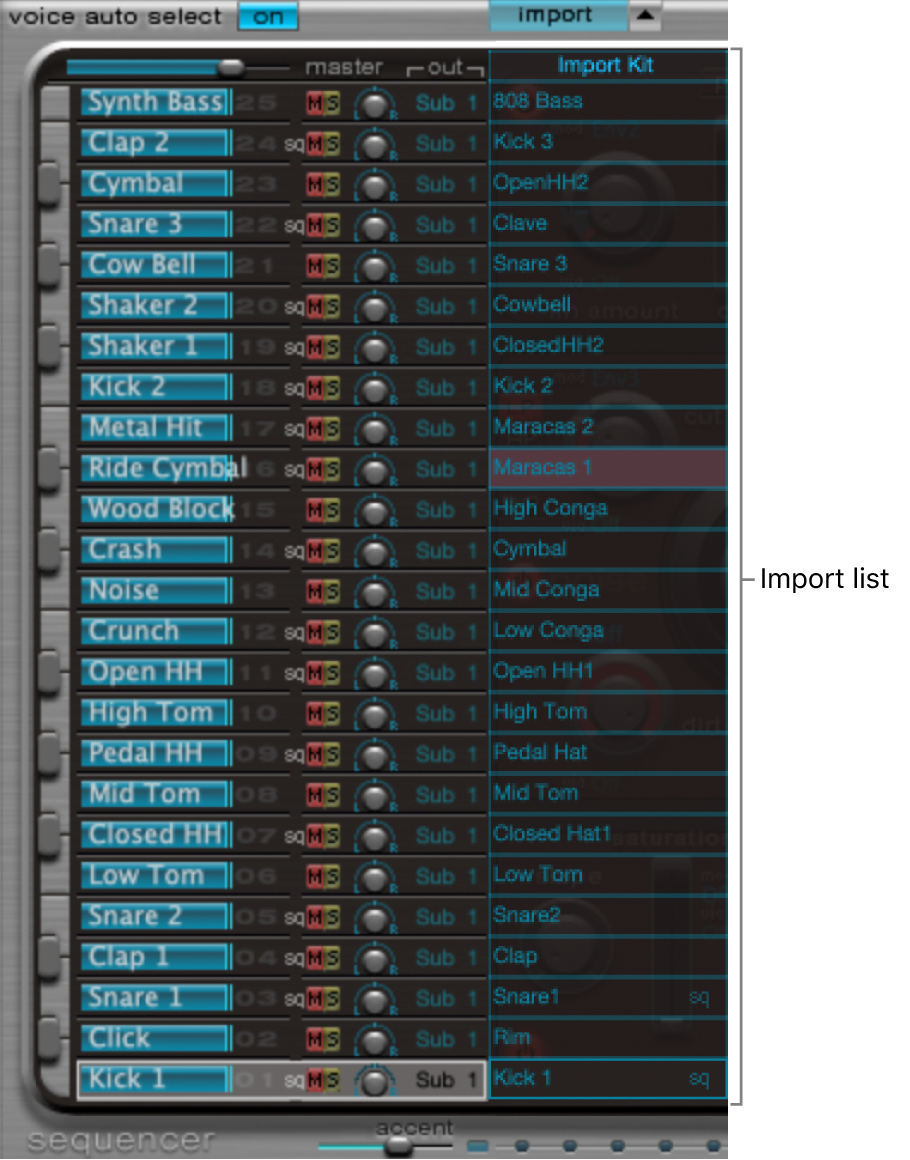MainStage User Guide
- Welcome
-
- Overview of Edit mode
-
- Select patches and sets in the Patch List
- Copy, paste, and delete patches
- Reorder and move patches in the Patch List
- Add and rename patches
- Create a patch from several patches
-
- Overview of the Patch Settings Inspector
- Select patch settings in the Patch Library
- Set the time signature for patches
- Change the tempo when you select a patch
- Set program change and bank numbers
- Defer patch changes
- Instantly silence the previous patch
- Change patch icons
- Transpose the pitch of incoming notes for a patch
- Change the tuning for a patch
- Add text notes to a patch
-
- Overview of channel strips
- Add a channel strip
- Change a channel strip setting
- Configure channel strip components
- Show signal flow channel strips
- Hide the metronome channel strip
- Create an alias of a channel strip
- Add a patch bus
- Set channel strip pan or balance positions
- Set channel strip volume levels
- Mute and solo channel strips
- Use multiple instrument outputs
- Use external MIDI instruments
- Reorganize channel strips
- Delete channel strips
-
- Overview of the Channel Strip Inspector
- Choose channel strip settings
- Rename channel strips
- Change channel strip colors
- Change channel strip icons
- Use feedback protection with channel strips
- Set keyboard input for a software instrument channel strip
- Transpose individual software instruments
- Filter MIDI messages
- Scale channel strip velocity
- Set channel strips to ignore Hermode tuning
- Override concert- and set-level key ranges
- Add text notes to a channel strip in the Channel Strip Inspector
- Route audio via send effects
-
- Screen Control Inspector overview
- Replace parameter labels
- Choose custom colors for screen controls
- Change background or grouped screen control appearance
- Set screen controls to show the hardware value
- Set parameter change behavior for screen controls
- Set hardware matching behavior for screen controls
- Reset and compare changes to a patch
- Override concert- and set-level mappings
-
- Overview of mapping screen controls
- Map to channel strip and plug-in parameters
- Map screen controls to actions
- Map a screen control to multiple parameters
- Use screen controls to display PDF document pages
- Edit the saved value for a mapped parameter
- Set drum pads or buttons to use note velocity
- Map screen controls to all channel strips in a patch
- Undo screen control parameter mappings
- Remove screen control mappings
- Work with graphs
- Create controller transforms
- Share patches and sets between concerts
- Record the audio output of a concert
-
- Overview of concerts
- Create a concert
- Open and close concerts
- Save concerts
- How saving affects parameter values
- Clean up concerts
- Consolidate assets in a concert
- Rename the current concert
-
- Overview of the Concert Settings Inspector
- Set MIDI Routing to channel strips
- Transpose incoming note pitch for a concert
- Define the program change message source
- Send unused program changes to channel strips
- Set the time signature for a concert
- Change the tuning for a concert
- Set the pan law for a concert
- Add text notes to a concert
- Control the metronome
- Silence MIDI notes
- Mute audio output
-
- Layout mode overview
-
- Screen control parameter editing overview
- Lift and stamp screen control parameters
- Reset screen control parameters
- Common screen control parameters
- Keyboard screen control parameters
- MIDI activity screen control parameters
- Drum pad screen control parameters
- Waveform screen control parameters
- Selector screen control parameters
- Text screen control parameters
- Background screen control parameters
- How MainStage passes through MIDI messages
- Export and import layouts
- Change the aspect ratio of a layout
-
- Before performing live
- Use Perform mode
- Screen controls in performance
- Tempo changes during performance
- Tips for performing with keyboard controllers
- Tips for performing with guitars and other instruments
- Tune guitars and other instruments with the Tuner
- The Playback plug-in in performance
- Record your performances
- After the performance
- Tips for complex hardware setups
-
- Overview of keyboard shortcuts and command sets
-
- Concerts and layouts keyboard shortcuts
- Patches and sets (Edit mode) keyboard shortcuts
- Editing keyboard shortcuts
- Actions keyboard shortcuts
- Parameter mapping (Edit mode) keyboard shortcuts
- Channel strips (Edit mode) keyboard shortcuts
- Screen controls (Layout mode) keyboard shortcuts
- Perform in Full Screen keyboard shortcuts
- Window and view keyboard shortcuts
- Help and support keyboard shortcuts
-
-
- Use MIDI plug-ins
-
- Arpeggiator overview
- Arpeggiator control parameters
- Note order parameters overview
- Note order variations
- Note order inversions
- Arpeggiator pattern parameters overview
- Use Live mode
- Use Grid mode
- Arpeggiator options parameters
- Arpeggiator keyboard parameters
- Use keyboard parameters
- Assign controllers
- Modifier controls
- Note Repeater controls
- Randomizer controls
-
- Use Scripter
- Use the Script Editor
- Scripter API overview
- MIDI processing functions overview
- HandleMIDI function
- ProcessMIDI function
- GetParameter function
- SetParameter function
- ParameterChanged function
- Reset function
- JavaScript objects overview
- Use the JavaScript Event object
- Use the JavaScript TimingInfo object
- Use the Trace object
- Use the MIDI event beatPos property
- Use the JavaScript MIDI object
- Create Scripter controls
- Transposer controls
-
-
- Alchemy overview
- Alchemy interface overview
- Alchemy Name bar
- Alchemy file locations
-
- Alchemy source overview
- Source master controls
- Import browser
- Source subpage controls
- Source filter controls
- Source filter use tips
- Source elements overview
- Additive element controls
- Additive element effects
- Spectral element controls
- Spectral element effects
- Pitch correction controls
- Formant filter controls
- Granular element controls
- Sampler element controls
- VA element controls
- Wide unison mode
- Source modulations
- Morph controls
- Alchemy master voice section
- Alchemy Extended parameters
-
- Playback plug-in overview
- Add a Playback plug-in
- Playback interface
- Use the Playback waveform display
- Playback transport and function buttons
- Playback information display
- Playback Sync, Snap To, and Play From parameters
- Use the Playback group functions
- Use the Playback Action menu and File field
- Use markers with the Playback plug-in
-
- Sample Alchemy overview
- Interface overview
- Add source material
- Edit mode
- Play modes
- Source overview
- Synthesis modes
- Granular controls
- Additive effects
- Additive effect controls
- Spectral effect
- Spectral effect controls
- Filter module
- Lowpass, bandpass, and highpass filters
- Comb PM filter
- Downsampler filter
- FM filter
- Envelope generators
- Mod Matrix
- Modulation routing
- Motion mode
- Trim mode
- More menu
-
- Sculpture overview
- Sculpture interface
- Global parameters
- Amplitude envelope parameters
- Use the Waveshaper
- Filter parameters
- Output parameters
- Define MIDI controllers
- Extended parameters
-
- Studio Piano
- Copyright

Import sounds into Ultrabeat in MainStage
Ultrabeat can directly import sampler instruments, in addition to loading audio samples and its own settings, or Drum Synth settings. This provides enhanced sound design and rhythm processing options for sampler instruments, along with the ability to play and control Sampler drum kits with the intuitive drum mixer layout and Ultrabeat sequencer.
There are two key elements that you use to import sounds and sequences into Ultrabeat:
Import button: Choose a kit that contains sounds or sequences you want to import.
Import list button: Hide or show the import list, then add drum sounds or sequences from Ultrabeat settings or sampler instruments to the active kit.
Open an Ultrabeat setting or sampler instrument with the import list
In MainStage, click the Import button.

Select the source Ultrabeat setting or sampler instrument in the dialog, then click Open.
A list of all sounds found in the selected setting, or samples in the sampler instrument, is shown to the right of the Assignment section Mixer.

Drag sounds into your drum kit
In MainStage, drag the sound name from the import list into the target row in the Mixer section.
Note: Hold down the Command key to include all sequences.
Transfer sounds using shortcut menu commands
In MainStage, Control-click (or right-click) the sound name in the import list, then choose Copy (Voice & Seq) from the shortcut menu.
The selected sound and its sequences are copied to the Clipboard.
Control-click (or right-click) the sound you want to replace in the current drum kit, then choose one of the following shortcut menu commands:
Paste Voice: Replaces the selected sound with the sound from the Clipboard but does not replace existing sequences.
Paste Sequence > (submenu): Opens a submenu that enables you to replace all, or individual sequences, of the target drum sound. Sound parameters are not affected.
Pasting a single sequence replaces the currently active sequence (as set in the Pattern menu) of the target drum sound. This allows you to copy sequences into any of the 24 possible pattern locations.
Swap with Clipboard: Exchanges and replaces the selected sound (and associated sequence) with the sound from the Clipboard.
Import a sampler instrument into Ultrabeat
In MainStage, drag a sampler instrument filename from the Finder directly onto the Assignment section.
Ultrabeat reproduces the Sampler layout as closely as possible. Layered Sampler zones are set up as layered drum sounds, using the sample playback mode of oscillator 2. See Use Ultrabeat oscillator 2 sample mode.
Note: This method does not allow paging through the sampler instrument if it contains more than 25 sounds (samples). Ultrabeat maps only sample zones and layers that fall within the Ultrabeat drum sound range of C1 to C3. All other samples (zones) are ignored.
Open Drum Synth settings with Ultrabeat
In MainStage, do one of the following:
Choose the Drum Synth setting name from the Ultrabeat Setting menu. Use the Load menu item to browse to the default location: ~/Music/Audio Music Apps/Plug-In Settings/Drum Synth.
The Drum Synth sound is loaded into the Assignment section. You can edit, process, and handle it as you would with any Ultrabeat sound.
Choose Ultrabeat from the Instrument pop-up menu on an instrument channel strip that contains a Drum Synth instance.
Drum Synth is replaced with Ultrabeat on the channel strip and the Drum Synth sound is automatically loaded into the Assignment section.